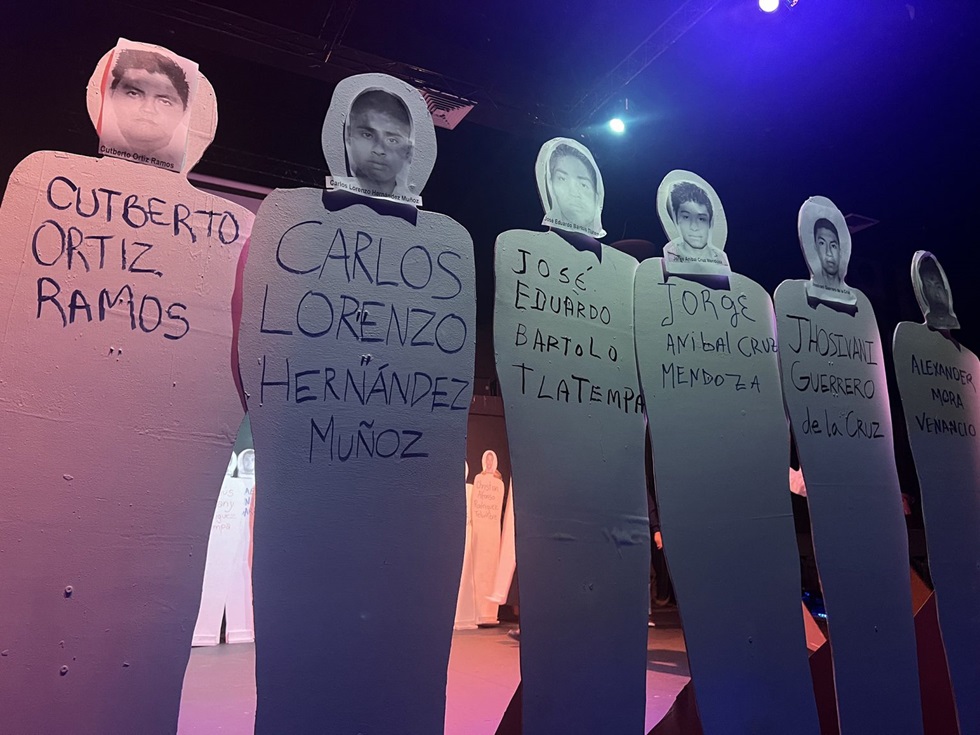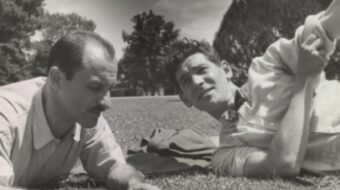
LOS ANGELES — A decade has passed since 43 young students from the all-male Ayotzinapa Rural Teachers College, in Tixtla in the state of Guerrero, were hijacked, attacked, shot at and otherwise forcibly “disappeared” at the hands of Mexican police, politicians, military and cartel members in deadly collusion. The politically engaged students had been traveling on a bus to the nearby city of Iguala to participate in a demonstration. There’s suspicion that an informer was posing as a student. The town’s mayor and his wife abruptly left in the wake of the incident.
To date, under the administrations of both the president at the time, Enrique Peña Nieto, and his successor Andrés Manuel López Obrador—and now Claudia Sheinbaum Pardo—scant progress has been made to determine who the killers were, nor in most cases where the bodies wound up. Some were apparently incinerated, but only the remains of three have been identified.
The cry “They were alive when they were taken, and we want them back alive!” (“¡Vivos se los llevaron, vivos los queremos!”) becomes ever more hollowly aspirational as the years go by, but the commitment to solidarity “Todos somos Ayotzinapa” (We’re all Ayotzinapa) remains.
The Los Angeles-based Grupo de Teatro SINERGÍA presented six performances of Ayotzinapa (Situación: Desaparecido), performed in Spanish with English supertitles, as part of Encuentro 2024: We Are Here–Presente!, a three-week national theater festival of dynamic, contemporary Latiné theater, involving 19 theater companies and 165 artists from across the U.S. and Puerto Rico, organized by the Latino Theater Company at The Los Angeles Theatre Center in downtown L.A. The festival ran from Oct. 24 through Nov. 10. We saw the 80-minute nonstop performance on Nov. 7.
Mexico has one of the highest rates of disappearances in the world, many the victims of femicide. Political, environmental and labor leaders have often been targeted for elimination as well. Drug cartels are frequently implicated, but their close relationships in many cases to government and police shield them from culpability.
What came out so vividly in the play was the character of this rural teachers college. It attracted almost exclusively dedicated young men, virtually all of them from Indigenous or mixed racial backgrounds, to become certified teachers, an honored profession, and for most a significant upgrade from their families’ general condition as peasants or day laborers. Many spoke Native languages and hoped to teach in bilingual schools in rural areas. Many planned to use their income to help support their parents and families. Their abduction and assassination spelled the erasure of Indigenous lives, futures and opportunities, as well as the furtherance of citizen distrust of their own government.
Possibly their example set the stage for AMLO, when he became president, to establish a new tranche of local universities in all the Mexican states.
Ruben Amavizca-Murúa is the credited writer and director of the play. If I’m not mistaken, it was he who introduced himself at the end (this informal part of the program went untranslated) as the teacher and director of the SINERGÍA (synergy) company. He drew his information about the 43 students from news articles and other public sources. His group of 13 actors apparently are members of his theater workshop, and they’d come from various countries of Latin America to Los Angeles. He must be a gifted teacher, because the cast gave their all in deeply affecting performances as fathers and mothers and other relations, friends, colleagues and fellow students who remembered the 43. I assume many of these actors are amateurs with other jobs, but they came across as seasoned professionals. I wonder if another company project might involve telling some of their own life stories.
The play takes the form of a roll call, as cast members carry out from the wings, one by one, a maquette of each student, with their full name handwritten on their chest and a photo of their face pasted on the head. Each of the 43 gets about a minute and a half, maybe two. Usually it’s more than one person who recalls them—his parents, or his classmates—and they are distinguished by dress, hats, footwear, scarves, serapes, baskets, sports items, to reflect their individual identities. Somewhat repetitious and formulaic, though never numbing, the laudable aim is to restore some sense of humanity to each victim.

With a cast of 13, they all play multiple roles in a swiftly moving pageant that evokes each student’s personality and character. Common features are their demeanor ranging from serious to playful, physical description (height, scars, birthmarks), what town and state they came from, their interests, hobbies, their humor, their laugh and smile, their friendliness, studiousness, dedication, helpfulness, romantic ties and plans for the future.
While each one is given a clear, distinct gloss, all together they seem to blend into a mass of names. Perhaps that’s inevitable in the case of a mass slaughter, but what the cast embodied in a deeply empathic way, and perhaps equally significant, is the hole their disappearance has created in the lives and families of those unfortunate 43. Most of the survivors do not seem resigned to their loss as a bad turn of fate. Instead, they are active in movements that continue to demand justice and answers. “Rebelliousness is the weapon of the future!” seems to be their mantra.
The talented cast (listed in the program without the normal accent marks) includes Marisela Lopez, Armando Heredia, Veder Vera, Rafael O Calderon, Oscar Roman, Gabriel Cruz, Christopher J Magallanes, Ovidio Gonzalez, Sergio Serdio, Moises Rodriguez, Juan Glezz, Laura Lalis, and Guadalupe Romero. The technical director is Max Brother and the stage manager is Rubén Alejandro.
Ayotzinapa has finished its run at Encuentro, but I imagine it could be remounted from time to time, maybe in other cities. It should be. I’ll be on the lookout for this plucky grupo de teatro’s next venture.
A review of the progress of the case on its 10th anniversary can be read here. The Wikipedia entry is quite detailed.
We hope you appreciated this article. At People’s World, we believe news and information should be free and accessible to all, but we need your help. Our journalism is free of corporate influence and paywalls because we are totally reader-supported. Only you, our readers and supporters, make this possible. If you enjoy reading People’s World and the stories we bring you, please support our work by donating or becoming a monthly sustainer today. Thank you!










